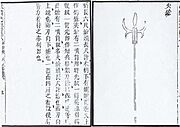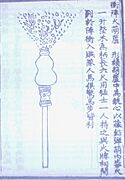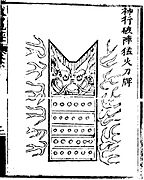Fire lance facts for kids
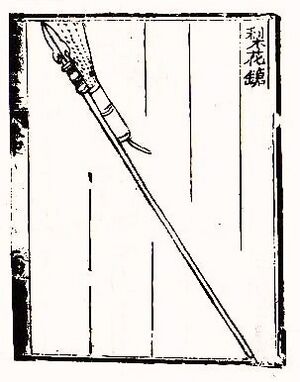
The fire lance was an early gunpowder weapon. It was like a very old version of modern firearms. It first appeared in China between the 900s and 1100s. It was used very well during the Jin-Song Wars.
At first, a fire lance was a small fire-starting device. It was attached to a long polearm weapon, like a spear. It was used to surprise enemies at the start of a fight. As gunpowder got better, the explosion became stronger. People also added small rocks or metal pieces to the blast. This made it act a bit like a modern flamethrower and a shotgun combined. However, it only worked at a very short distance (about 3 meters or 10 feet). Most fire lances could only fire once. Some were made to fire twice. By the late 1200s, fire lances had metal barrels. This made them stronger for the blast. The spear part was removed. These metal-barreled weapons became the first hand cannons.
Contents
How Fire Lances Were Made
The first fire lances were tubes, often made of bamboo. They held gunpowder and a slow-burning fuse. These tubes were tied to a spear or another pole weapon. When lit, the gunpowder would shoot out flames towards the spear tip. Later, people added things like iron pellets or pottery pieces to the gunpowder. When fired, the gunpowder blast would push these pieces out with the flames.
Around the mid-1200s, metal barrels for fire lances started to appear. These metal barrels began to be used on their own, without the spear. A metal barrel used by itself was called an 'eruptor'. It was an early version of the hand cannon. In Europe, some versions used wooden tubes.
History of the Fire Lance
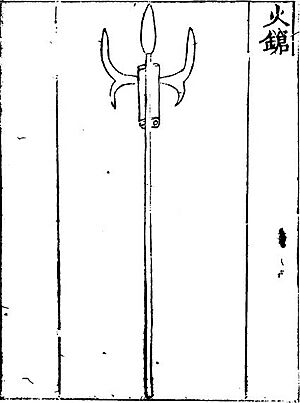
Early Use in China
The first signs of fire lances come from China in the year 950. But we don't hear about them being used in wars until 1132. This was when soldiers in the Song dynasty used them. They used them during the Siege of De'an against the Jin dynasty (1115–1234).
In 1163, fire lances were put on war carts. These carts were called "at-your-desire-carts." They helped protect large machines that threw firebombs. By the late 1100s, people added small pieces of shrapnel, like broken pottery and tiny iron pellets, to the gunpowder tubes. Eventually, fire lances stopped having a spear tip. They relied only on their powerful blast.
By 1232, the Jin dynasty also used fire lances. Their versions had better, reusable barrels made of strong paper. A historical book, the History of Jin, says these fire lances could reach about three meters (ten feet). It describes how they were made with many layers of paper and filled with charcoal, iron pieces, sulfur, and other things. When fired, flames would shoot out more than ten feet. The tube would not be destroyed after firing.
In 1233, Jin soldiers used fire lances very well against the Mongols. A leader named Pucha Guannu led 450 Jin fire lancers. They defeated a whole Mongol camp. Mongol soldiers reportedly feared the fire lance, even though they didn't think much of other Jin weapons.
In 1259, a wad of pellets was used to block the barrel of a fire lance. This made it the first recorded use of a bullet in history. By 1276, fire lances had metal barrels. Cavalry soldiers also started using fire lances. The Huolongjing book also mentions a special gourd-shaped fire lance. Both cavalry and foot soldiers used this type.
The metal-barreled fire lance began to be used on its own around the mid to late 1200s. These early cannons, which fired projectiles, were called 'eruptors'. They were the first versions of the hand cannon.
Later History Around the World
By 1280, the Middle East had also started using fire lances. In 1396, knights in Europe began to use fire lances while riding horses. In the 1400s, Japanese samurai also used fire lances.
The last time fire lances were recorded being used in Europe was during the Storming of Bristol in 1643. However, England was still giving them to ships as late as 1660.
Troncks
In Europe, some versions of fire lances were called Troncks, fire-trunks, or bombas. These had fireworks and shot placed in a wooden tube at the end of a pole. The fireworks inside had parts that burned slowly and parts that burned fast.
Troncks were often given to warships. One example was found in a sunken ship called the La Trinidad Valencera. When people tried to rebuild and test one in 1988, several parts of the Tronck caught fire at the same time.
Gallery
-
The 'phalanx-charging fire-gourd' from the Huolongjing. It shows lead pellets shooting out with the gunpowder blast.
-
A 'divine moving phalanx-breaking fierce-fire sword-shield' from the Huolongjing, around 1360-1375. This was a shield with fire lances used to break enemy lines.
See also
- Early modern warfare
- Science and technology of the Song dynasty
- Jiao Yu
- Huolongjing
- Xun Lei Chong
- Lunge mine


